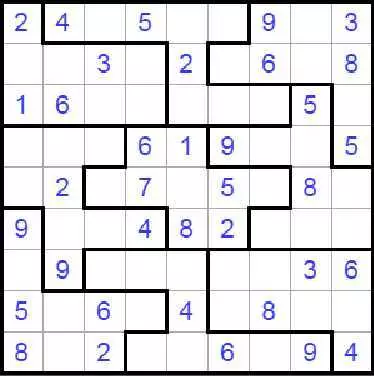Next
 Previous
Previous
Нерегулярный Судоку "#8" Легкий (Судоку Пазл, Jigsaw Sudoku, Nonomino Sudoku, Irregular Sudoku) • Размер: 9х9

На нашем портале crossword.nalench.com собраны лучшие Нерегулярные судоку головоломки которые можно разгадать онлайн. Также есть раздел Судоку онлайн, разгадать судоку, Нерегулярные судоку, судоку 9х9, судоку онлайн, судоку для детей, судоку онлайн бесплатно без регистрации. Судоку, судоки, онлайн судоку, разгадать судоку, sudoku, sudoku online free, головоломки, судоку играть онлайн, судока, судоку играть, головоломки онлайн, судоку-онлайн, головоломка, Нерегулярный судоку, судоку онлайн головоломка, игра, онлайн, квадрат. Генератор судоку, обычный, простой, сложный, правила разгадывания, ответы на кроссворды, японская головоломка, игра, судоку онлайн, судоку играть, судоку играть онлайн, бесплатные судоку, судоку играть бесплатно, судоку онлайн бесплатно, судоку играть онлайн бесплатно, судоку скачать, судоку для печати, судоку игра, судоку сложные Do you like the stuff? We will be grateful for the reposts.
 Previous
PreviousНерегулярный Судоку "#8" Легкий (Судоку Пазл, Jigsaw Sudoku, Nonomino Sudoku, Irregular Sudoku) • Размер: 9х9
Irregular sudoku 8 (Sudoku Jigsaw, Kikagaku Nanpure) is a number puzzle. Translated from Japanese, “su” means “number”, and “dock” means “standing separately”.
In a Irregular sudoku puzzle, the grid is a 9x9 square divided into smaller squares with a side of 3 cells (“regions”). Thus, the entire field has 81 cells. Some of them already have numbers (from 1 to 9). Depending on how many cells are already filled, the puzzle task can be attributed to easy or difficult.
Irregular sudoku puzzles have only one rule. It is necessary to fill in the free cells so that in each row, in each column and in each small 3x3 square, each digit from 1 to 9 would occur only once.
Lovers of puzzles will also like it The Top 8 Benefits of Doing Jigsaw Puzzles.
In a Irregular sudoku puzzle, the grid is a 9x9 square divided into smaller squares with a side of 3 cells (“regions”). Thus, the entire field has 81 cells. Some of them already have numbers (from 1 to 9). Depending on how many cells are already filled, the puzzle task can be attributed to easy or difficult.
Irregular sudoku puzzles have only one rule. It is necessary to fill in the free cells so that in each row, in each column and in each small 3x3 square, each digit from 1 to 9 would occur only once.
Lovers of puzzles will also like it The Top 8 Benefits of Doing Jigsaw Puzzles.

Answer to Irregular sudoku 8
На нашем портале crossword.nalench.com собраны лучшие Нерегулярные судоку головоломки которые можно разгадать онлайн. Также есть раздел Судоку онлайн, разгадать судоку, Нерегулярные судоку, судоку 9х9, судоку онлайн, судоку для детей, судоку онлайн бесплатно без регистрации. Судоку, судоки, онлайн судоку, разгадать судоку, sudoku, sudoku online free, головоломки, судоку играть онлайн, судока, судоку играть, головоломки онлайн, судоку-онлайн, головоломка, Нерегулярный судоку, судоку онлайн головоломка, игра, онлайн, квадрат. Генератор судоку, обычный, простой, сложный, правила разгадывания, ответы на кроссворды, японская головоломка, игра, судоку онлайн, судоку играть, судоку играть онлайн, бесплатные судоку, судоку играть бесплатно, судоку онлайн бесплатно, судоку играть онлайн бесплатно, судоку скачать, судоку для печати, судоку игра, судоку сложные Do you like the stuff? We will be grateful for the reposts.
Comments:
Comment on the crossword by leaving a review!
New crossword puzzle comments:
Петро Полюхович © 2011-2024
Join us if you are a true crossword puzzler!


 Login
Login Crosswords
Crosswords Conundrums
Conundrums Sudoku
Sudoku English
English Turkish
Turkish About
About